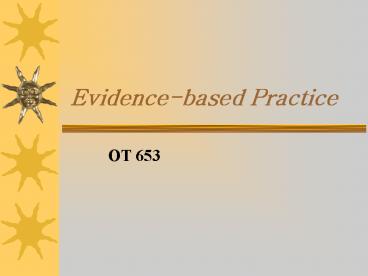Evidencebased Practice - PowerPoint PPT Presentation
1 / 18
Title:
Evidencebased Practice
Description:
... many people had felt that citrus fruits might reduce the incidence of scurvy ... and evaluated six potential treatments one of which involved using citrus fruits. ... – PowerPoint PPT presentation
Number of Views:152
Avg rating:3.0/5.0
Title: Evidencebased Practice
1
Evidence-based Practice
- OT 653
2
What does evidence-based practice mean to you???
3
The integration of individual clinical expertise
with the conscientious, explicit and judicious
use of current best evidence in making decisions
about the care of individual patients. (Sackett,
Rosenburg, Gray, Haynes, Richardson, 1996, p.
71)
4
The process of systematically finding,
appraising, and using contemporaneous research
findings as the basis for clinical decisions
(Rosenburg Donald, 1995, p. 1122)
5
How is evidence-based practice different than
what occupational therapy clinicians usually do?
6
What is the history of EBM?
7
In the reign of the Emperor Qianlong (1688-1766),
a method known as "kaozheng" (practising
evidential research) was apparently practised in
relation to Confucian medical texts.
8
The first reported controlled therapy trial took
place in the United Kingdom in 1747. Since the
early 1600s, many people had felt that citrus
fruits might reduce the incidence of scurvy
during long ocean voyages. James Lind studied
sailors with scurvy and evaluated six potential
treatments one of which involved using citrus
fruits.
9
the origins of EBP lie in Revolutionary France
but were further developed via the influential
ideas of Pierre Louis in the mid-nineteenth
century. Louis developed a numerical method for
assessing treatment which he used, in one
instance, to provide evidence that blood-letting
was useless although physicians largely ignored
his discoveries..
10
Contribution of Outcomes Research
- Outcomes are results of treatment which have an
impact on relevant components of the patients
life - The field evolved because of increasing costs
with little evidence of change in outcomes
11
Wennbergs studies
- 1973 found that the rate of hysterectomies
varied from 20 to 60 per 10,000 women depending
on where data was collected - Tonsillectomies ranged from 15-151 per 10,000
persons - 1990 found that less invasive and lower costs
treatments for prostate cancer had the same
outcomes as more costly treatments
12
Wennbergs work generated concern about how
health care dollars were spent and how health
care decisions were made
13
1987- Development of the McMaster Health
Information Research Unit which developed EBM to
teach medical students
14
EBM evolved from a teaching tool to the
recognized trend in good health care practice
15
Enter the Cochrane Collection - 1993
16
(No Transcript)
17
Archie Cochrane suggested that, because health
care resources would always be limited, they
should be used to provide equitably those forms
of health care which had been shown in properly
designed evaluations to be effective. In
particular, he stressed the importance of using
evidence from randomized controlled trials (RCTs)
because these were likely to provide much more
reliable information than other sources of
evidence.
18
AOTA Stance on EBP
- AOTA has made a strong commitment to EBP
- AJOT has published a series of articles on EBP,
and several other OT journals include articles on
the topic as well - EBP has become the norm for most health care
professions - Getting practitioners to use the method remains a
challenge.































